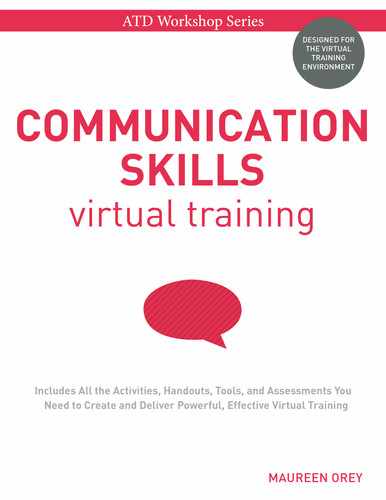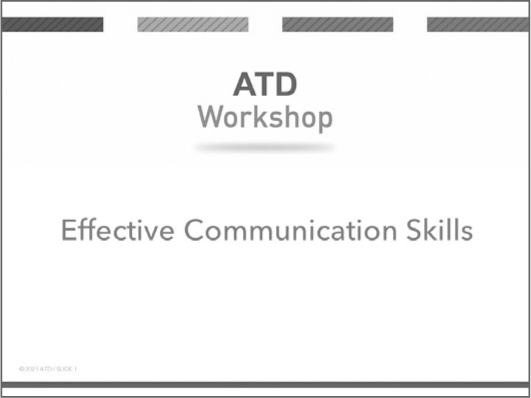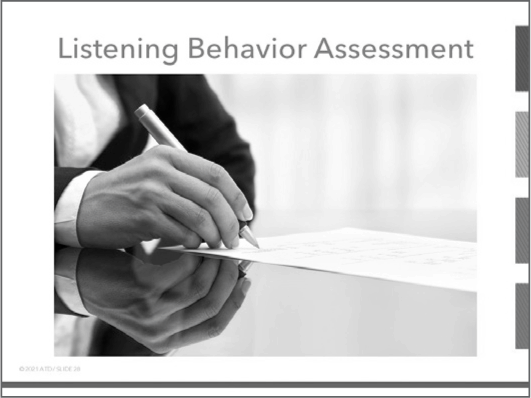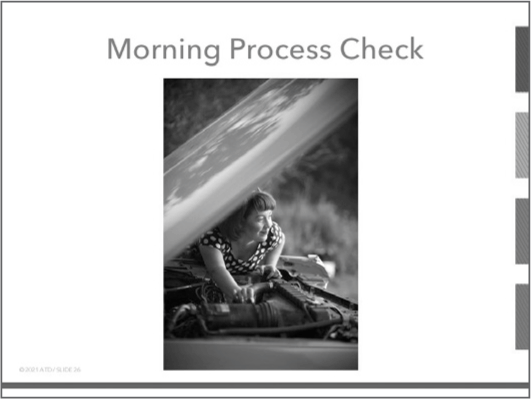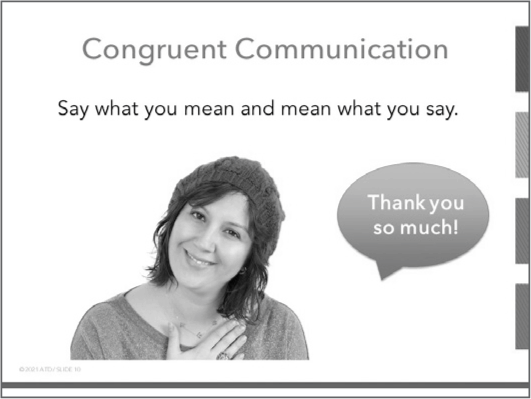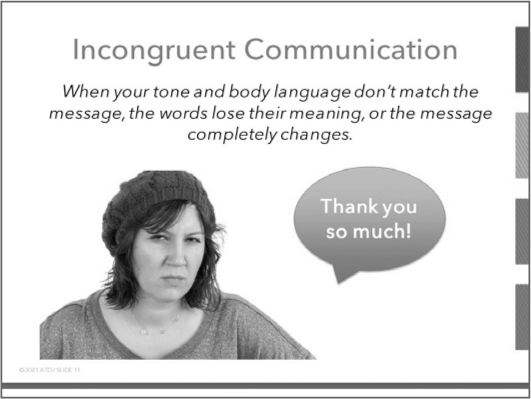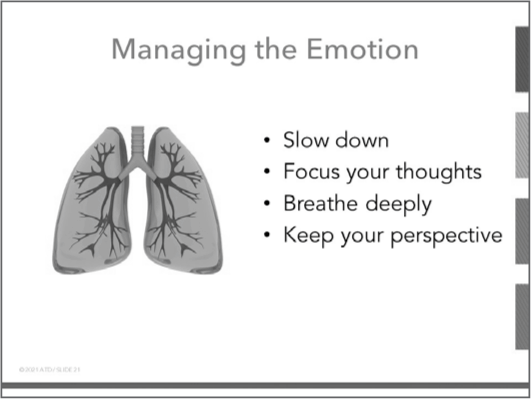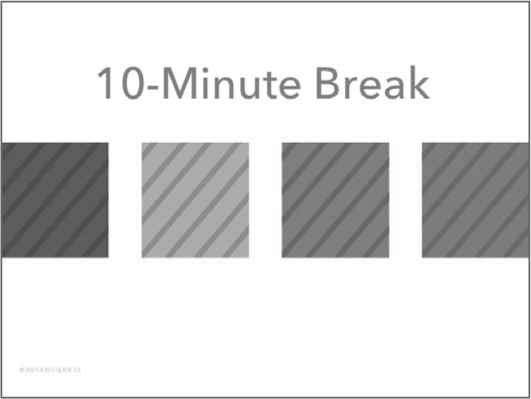Chapter 2
One-Day Communication Skills Workshop
What’s in This Chapter
• Objectives of the one-day communication skills workshop
• Summary chart for the flow of content and activities
• One-day program agenda
There are a couple of different approaches to holding a one-day workshop. You can choose a theme and provide a deep dive into one aspect of communication, or you can take a broader look at a variety of topics such as listening, oral communication, virtual communication, challenging discussions, or written communication. The challenge of the latter approach of including a number of different aspects of communication in a one-day workshop is that there is very little time to explore the topics in depth or to practice the skills; at the end of the day the participant may leave the workshop with a lot of information and very little practiced skill.
For that reason, this one-day workshop is deliberately designed with the deep-dive approach in mind. In one day, participants can explore a concentrated topic more thoroughly, as well as have the opportunity to practice the skills they are learning. There is also more time for discussion and reflection to enhance learning and retention. As with the two-day workshop design, an effective one-day workshop must account for and anticipate the natural and predictable low energy times during the day. Activities that engage participants in relevant and meaningful small-group discussion and practice are essential to a successful training event.
A full-day workshop requires the facilitator to have a high level of energy and focus and a keen ability to read the energy level of the participants throughout the duration of the program. You can keep your participants engaged and the energy high by managing the flow of activities, presentations, and small- or large-group discussions. Consider changing your training method every 10 to 15 minutes.
This chapter provides a one-day workshop agenda using active training techniques. It is designed to keep the content relevant, meaningful, and interactive. The day begins with one of the most important aspects of communication: listening. Throughout the day, the content focuses on how to listen actively and how to deliver your message effectively.
One-Day Workshop Objectives
By the end of the one-day workshop, participants will be able to:
• Assess their personal listening skills
• Explain and practice active listening skills
• Determine the best way to get their points across
• Identify the most common barriers to communication
• Explore the role emotion plays in communication and discuss strategies and techniques for managing its impact
One-Day Workshop Overview
Workshop Overview
| Topics | Timing |
Welcome and Introduction |
10 minutes |
Learning Activity 1. Objective Decision |
15 minutes |
Ground Rules and Expectations |
10 minutes |
Learning Activity 2. The Most Difficult Person |
15 minutes |
Assessment 1. Listening Behavior Assessment |
15 minutes |
BREAK |
10 minutes |
Learning Activity 6. Listening Is More Than Hearing |
30 minutes |
Basic Listening |
10 minutes |
Learning Activity 7. The Listening Stick (Part 1) |
15 minutes |
BREAK |
10 minutes |
Principles of Active Listening (Part 1) Skills and Rephrasing |
15 minutes |
Principles of Active Listening (Part 2) Paraphrasing and Empathy |
15 minutes |
Learning Activity 8. Listening Stick (Part 2) |
20 minutes |
Small Group Brainstorm: Barriers to Listening |
15 minutes |
Morning Debrief |
10 minutes |
LUNCH |
60 minutes |
Communication Model Process |
10 minutes |
Learning Activity 3. Identify the Noise |
15 minutes |
The Communication Pie (Three Modes of Communication) |
10 minutes |
Learning Activity 4. Impression Improv |
20 minutes |
Congruent Communication |
5 minutes |
Incongruent Communication |
5 minutes |
BREAK |
10 minutes |
Vocal Tone and Word Emphasis |
10 minutes |
The Role of Emotion in Communication |
5 minutes |
The Emotional and Rational Brain |
5 minutes |
Emotional Hijacking and the Reptilian Brain |
5 minutes |
Strategies for Gaining Emotional Control |
15 minutes |
Managing the Emotion |
5 minutes |
Communication Awareness Model |
10 minutes |
BREAK |
10 minutes |
Learning Activity 5. Surgical Analysis of Your Story |
35 minutes |
Reflection and Action Plan |
10 minutes |
Summary: Take Aways |
10 minutes |
Final Q&A and Evaluations |
10 minutes |
TOTAL |
480 minutes (8 hours) |
Considerations for the Virtual Environment
Conducting a workshop in a virtual format is often necessary to provide benefits of time and location flexibility as well as to account for cost. Unfortunately, this modality also brings the risk of some challenges, such as technology limitations, distracted learners, a lack of nonverbal cues, and the highly beneficial informal, but relevant, sidebar conversations that take place among learners in a shared space with a shared interest. When considering conducting a workshop in a virtual format, the following recommendations may help minimize some of these risks:
• Consider breaking up the content into smaller chunks. Ideally, virtual sessions should be no longer than two to four hours a day. See chapter 4 for suggestions on how this content can be grouped into shorter or topic-specific sessions.
• To keep participants engaged, ensure that you maintain a high level of energy and frequently solicit input, both verbal and through the use of the technology tools throughout the duration of the workshop.
• Actively seek frequent feedback from participants to gauge their understanding.
• Use the video feature as much as possible so that participants can see that they have an instructor who is working with them and not just sharing static slides on a screen.
• Encourage participants to use their video features when speaking to help better engage with one another.
Preparation
While all facilitation sessions require preparation, the success of a virtual session is even more dependent on how carefully the facilitator prepares and the completion of a thorough and deliberate setup. The following checklists have been provided to help you ensure a smooth and effective workshop delivery. Please note, these checklists have been created with a WebEx environment in mind. As technologies and platforms can differ, you are encouraged to modify these recommendations based on the specific needs of your delivery.
Pre-Workshop—Facilitator Checklist
| ✓ | TASK | SUGGESTED TIMEFRAME |
|
Upload the presentation files. |
One week prior to the session. |
|
Review the facilitator guide and any other course materials. |
Ideally, one week prior to the start of the session, but no later than 72 hours in advance. |
|
Validate the final participant list. |
Ideally, one week prior to the start of the session, but no later than 72 hours in advance. |
|
Send a welcome email to participants. Let them know you are looking forward to the class, and include reminders to complete any necessary prework and to verify connection and compatibility. Highlight the fact that this is designed to be an interactive workshop, which means that they may be asked to share their screen and video camera during the sessions so may want to ensure appropriate and respectful appearance and attire. In addition, they will be asked to interact with others in the session frequently and will need to minimize any external distractions to get the most favorable learning experience from the course. |
One week prior to the session. |
|
Create polls and breakout rooms. |
At least 72 hours before the session. |
|
Ensure you’re familiar with how the interactivity functionality within your presentation platform works. You need to be able to explain this to participants. You may also want to create a short cheat sheet that you can use to demonstrate these functions as you welcome participants to the session. This is particularly important if you are conducting a session for participants from multiple organizations. |
At least 72 hours before the session. |
Create Polls
Create these polls before the start of the workshop. Ensure that each poll is set to share responses with all participants.
| ✓ | LOCATION | POLL RESPONSES |
|
Slide 2 (Objectives) |
• Assess your personal listening skills. • Explain and practice active listening skills. • Determine the best way to get your point across. • Identify the most common barriers of communication. • Explore the role emotion plays in communication and discuss strategies and techniques for managing its impact. |
|
Slide 77 |
• Speaker • Listener |
|
Slide 8 |
• Words we use • How we say words, tone of voice, style • Facial expression, body language |
Create Breakout Rooms
Create these breakout rooms before the start of the workshop. Create a list of who has been assigned to each room that you can display onscreen at the start of the activity.
| ✓ | ROOM DESCRIPTION | NOTES |
|
Create enough breakout rooms that the participants can be split into groups of five or fewer. Randomly assign each participant to a room so that the groups are roughly equal in number. Label rooms: • Room 1 • Room 2 • Room 3 • Room 4 • and so on |
You will use these breakout rooms for the following activities: • Barriers to Listening • Learning Activity 3. Identify the Noise • Learning Activity 5. Surgical Analysis of Your Story |
|
Create enough breakout rooms to accommodate breaking the group up into pairs. For example, if you have 20 participants, you will need 10 breakout rooms. Randomly assign each participant to a room. Label rooms: • Pair 1 • Pair 2 • Pair 3 • Pair 4 • and so on |
You will use these breakout rooms for the following activity: • Learning Activity 7. Listening Stick (Part 1) • Learning Activity 8. Listening Stick (Part 2) |
One-Day Workshop Agenda
Day 1 (8 a.m. to 4 p.m.)
| TIMING | SLIDES | ACTIVITIES/NOTES/CONSIDERATIONS |
8 a.m. (10 min) |
Slide 1
|
Welcome and Introduction Briefly welcome the participants and introduce yourself. Provide a quick overview of the functionality and interactivity elements that will be used during the session (e.g., polls, chat, whiteboard, breakout sessions). A sample functionality overview has been provided. This sample is specific to the WebEx environment. Ensure that participants are aware that they may be asked to share their screens or cameras as part of the exercises and activities during the workshop. |
8:10 a.m. (15 min) |
Slide 2
|
Learning Activity 1. Objective Decision • Handout 1b. Objective Decision • Poll: Objectives This activity provides an innovative way to facilitate the discussion about session objectives rather than simply reading them to the participants. Ask participants to follow the instructions in the handout. When they are finished ask them to use the poll to select the objective that corresponds to the one they highlighted. Share poll results with all. |
8:25 a.m. (10 min) |
Slide 3
|
Ground Rules and Expectations Facilitate a discussion about ground rules and expectations for the course. Adjust times as needed for starting, breaks, and lunches. It is important to establish a positive learning environment. Ask participants to give you a green check if they are in agreement with the ground rules for the session. |
8:35 a.m. (15 min) |
Slide 4
|
Learning Activity 2. The Most Difficult Person • Handout 2. The Most Difficult Person in the World Get participants thinking by using Handout 2. Debrief the questions using any method you wish (e.g., chat pane or raise hand). Capture responses on the whiteboard so that all can see. |
8:50 a.m. (15 min) |
Slide 28
|
Assessment 1. Listening Behavior Assessment Instruct participants to complete the assessment on listening behaviors. The tool also includes instructions to score the assessment. Facilitate a large-group discussion once all participants have completed the instrument. Ask: • What did you notice about yourself? • What were you surprised about? • What should you do differently? Instruct participants to type their responses in chat or on the whiteboard. Read them aloud as they come in, and select one or two people to elaborate. Invite participants to use the raise hand function to add insights or ask questions. |
9:05 a.m. (10 min) |
Slide 16
|
BREAK Encourage participants to get up and move around. Emphasize that they should try to look away from their computers or phones during the break if possible. |
9:15 a.m. (30 min) |
Slide 29
|
Learning Activity 6. Listening Is More Than Hearing Follow the instructions provided in the learning activity. Debrief the questions using any method you wish (e.g., chat pane or raise hand). |
9:45 a.m. (10 min) |
Slide 30
|
Basic Listening • Handout 10. Mistakes in Listening Explain and define the features involved in typical, nonempathetic listening (shown on the slide). The listening skills content starts with “typical” listening and then moves into active listening skills in later slides. Encourage participants to capture notes and insights on the handout. |
9:55 a.m. (15 min) |
Slide 32
|
Learning Activity 7. Listening Stick (Part 1) • Breakout Room Tell participants that they have been randomly paired and assigned to breakout rooms for this activity. Post the list of pairs on the screen. The objective of this activity is for the participants to experience ineffective listening. Display Slide 32, which provides brief instructions for the participants. Refer to the learning activity for directions on the facilitation process. |
10:10 a.m. (10 min) |
Slide 16
|
BREAK Encourage participants to get up and move around. Emphasize that they should try to look away from their computers or phones during the break if possible. |
10:20 a.m. (15 min) |
Slide 33
|
Principles of Active Listening (Part 1) Show the Franklin Covey quote on Slide 30 about active/empathetic listening to introduce the concept of active listening (in contrast to typical listening, which is usually a more common experience). Ask participants to read the quote and give you a green check when they are finished. Wait for green checks. Explain that empathetic/active listening is: • Motivated by a sincere desire to understand • Built one step at a time • Founded on character and trust • Interactive, sincere dialogue • Focused on understanding, not “fixing” (Slide 1 of 4) |
|
Slide 34
|
Principles of Active Listening (Part 1): Skills • Handout 11. Active Listening Present the four skills at the heart of active, empathetic listening: repeat, rephrase, reflect, rephrase/reflect. Encourage participants to follow along and take notes on the handout. (Slide 2 of 4) |
|
Slide 35
|
Write the question “Why Rephrase?” on the whiteboard. Ask participants to use their text tool to write a brief note on the whiteboard that suggests why it is important to rephrase. Alternately, participants may enter their responses in chat. Select a few to read aloud. Ask if anyone would like to elaborate on their thoughts. Then move to the next slide to explain in more detail why rephrasing is an important aspect of active listening. (Slide 3 of 4) |
|
Slide 36
|
Principles of Active Listening (Part 1): Rephrasing • Handout 11. Active Listening Explain why rephrasing is important when practicing active listening. (Slide 4 of 4) |
10:35 a.m. (15 min) |
Slide 37
|
Principles of Active Listening (Part 2): Paraphrasing • Handout 11. Active Listening Present tips on rephrasing and paraphrasing. Emphasize the importance of personalizing the approach so you don’t sound scripted or insincere. (Slide 1 of 3) |
|
Slide 38
|
Write the question “What is empathy?” on the whiteboard. Ask participants to use their text tool to write a brief phrase on the whiteboard that defines empathy. Alternately, participants may enter their responses in chat. Select a few to read aloud. Ask if anyone would like to elaborate on their thoughts. Then move to the next slide to define and discuss empathy as it relates to active listening. (Slide 2 of 3) |
|
Slide 39
|
Principles of Active Listening (Part 2): Empathy Guidelines • Handout 11. Active Listening Define empathy: “Empathy expresses how you think the other feels and why. It does not mean that you agree or feel the same way.” Present guidelines for communicating with empathy. Explain that these sample phrases are meant to be starters to help them practice. It is always better to find your own words so you don’t sound scripted or rehearsed. (Slide 3 of 3) |
10:50 a.m. (20 min) |
Slide 40
|
Learning Activity 8. Listening Stick (Part 2) Tell participants that they will return to their pair breakout rooms for this activity. Post the list of pairs on the screen. The objective of this activity is for participants to experience and practice active listening. Display Slide 40, which provides brief instructions for the participants. Refer to the learning activity for directions on the facilitation process. (Slide 1 of 3) |
|
Slide 77
|
Conduct a poll asking participants which role they preferred. • Speaker • Listener Select a few people at random to elaborate on their experience and response. (Slide 2 of 3) |
|
Slide 78
|
Display Slide 78 to share this key information about active listening. (Slide 3 of 3) |
11:10 a.m. (15 min) |
Slide 42
|
Small Group Brainstorm: Barriers to Listening • Handout 12. Barriers to Effective Listening • Breakout Room • Whiteboard Display the question on Slide 42 and tell participants they will be working in groups to brainstorm things that get in the way of listening. Inform participants that they have been randomly broken into small groups for this learning activity. Show the list of participant assignments on the screen. Ask participants to join their assigned breakout rooms to discuss Handout 12 and record their ideas. Bring everyone back to the main room and ask each group to report what barriers to listening they identified. As participants share, capture their ideas on the whiteboard. Time permitting, you could share a time you experienced a barrier to listening and what happened as a result. |
11:25 a.m. (10 min) |
Slide 26
|
Morning Debrief As a morning process check, conduct a large-group discussion about emotion, communication, and having difficult conversations. Use the green check, red X, or raise hand functions to solicit interactions. |
11:35 a.m. (60 min) |
Slide 27
|
LUNCH Encourage participants to get up and move around. Emphasize that they should try to look away from their computers or phones during the break if possible. |
12:35 p.m. (10 min) |
Slide 5
|
Communication Model Process Present the communication process diagram (Slide 5). Explain the process of miscommunication and how “noise”—real and perceived—can influence the communication process. |
12:45 p.m. (15 min) |
Slide 7
|
Learning Activity 3. Identify the Noise • Handout 3. Causes of Miscommunication • Breakout Room Direct participants to the handout. Tell participants that they will be working in groups to identify and discuss the sources of noise that create miscommunication. Show the list of breakout room assignments on the screen. Give the groups 5–7 minutes to complete the handout. Bring everyone back to the main room and debrief the questions using any method you wish (e.g., chat pane or raise hand). Be sure to capture the ideas on the whiteboard. |
|
Slide 8
|
Poll Ask participants to rank the importance of three aspects of communication: • Words we use • How we say words, tone of voice, style • Facial expression and body language Share the poll results and introduce the next slide. |
1 p.m. (10 min) |
Slide 9
|
The Communication Pie (Three Modes of Communication) • Handout 4. The Importance of Body Language Present the communication pie and explain the importance of how you’re conveying your attitude and emotion through nonverbal communication. Direct participants to Handout 4. Emphasize the fact that 93 percent of communication is nonverbal. Note: Data on the share of communication that is verbal versus nonverbal has been debated for decades, including the Mehrabian (1981) data presented here. The exact share, give or take a few percentage points, is not as important as the understanding that most communication is nonverbal. As a result, nonverbal behavior is the most crucial aspect of communication—to what degree depends on both the situation and the individual. |
1:10 p.m. (20 min) |
Slide 79
|
Learning Activity 4. Impression Improv • Handout 5. Impression Improv In this activity, participants have fun demonstrating and identifying what impression people create based on a combination of what they say, how they say it, and what they do while saying it. Refer to the learning activity for directions on the facilitation process. When the activity is complete, debrief the questions using any method you wish (e.g., chat pane or raise hand). |
1:30 p.m. (5 min) |
Slide 10
|
Congruent Communication • Handout 6. Impact of Congruent Communication Direct participants to Handout 6. Present the information about being congruent when you communicate. When your body language and tone match the words in your message, you are perceived as credible and believable. (Slide 1 of 2) |
1:35 p.m. (5 min) |
Slide 11
|
Incongruent Communication When communication is incongruent, your body language and tone do not match the words in your message, and you will come across as insincere, disingenuous, and possibly manipulative. (Slide 2 of 2) |
1:40 p.m. (10 min) |
Slide 16
|
BREAK Encourage participants to get up and move around. Emphasize that they should try to look away from their computers or phones during the break if possible. |
1:50 p.m. (10 min) |
Slide 12
|
Vocal Tone and Word Emphasis The key point here is that your words send different messages depending on the tone and emphasis you use. Say, “I didn’t steal your cow yesterday,” six times. Each time emphasize a different word (I, didn’t, steal, your, cow, and yesterday) and see how the meaning changes. For example, when you emphasize “I,” it can sound as if you didn’t steal the cow, but you know who did. To create class interaction, ask different participants to say the sentence while emphasizing a different word. Use the raise hand feature to ask for volunteers. This is a great place to point out how being in a virtual setting can influence the way a message is heard by the audience. This is especially true if you’re not using a camera because the audience doesn’t have the benefit of seeing any nonverbal cues. |
2 p.m. (5 min) |
Slide 13
|
The Role of Emotion in Communication • Handout 7. The Role of Emotion in Communication This transition slide helps you shift the focus to the relationship between emotion and communication. Briefly discuss how quickly strong emotions can derail communication. Direct participants to Handout 7. Ask participants if they have experienced a situation where emotions derailed communication. Use a green check for yes and red X for no. Ask participants to raise their hand to share their experiences. Perhaps even tell a story about when this happened to you. (Slide 1 of 6) |
2:05 p.m. (5 min) |
Slide 15
|
The Emotional and Rational Brain • Handout 8. Emotions and the Brain Explain the roles of the emotional and rational brain. To make good decisions we need our whole brain to work effectively, yet our emotional brain receives the information first. If we overreact to input, we may find it difficult to handle a situation effectively. Direct participants to record their notes and insights in Part 1 of Handout 8. (Slide 2 of 6) |
2:10 p.m. (5 min) |
Slide 17
|
Emotional Hijacking and the Reptilian Brain Present the concept of emotional hijacking and the role of our reptilian brain (which is somewhat animalistic and unedited). When we are overcome with emotion, it’s as if our brain is “hijacked” and cannot think clearly. You can learn more about emotional hijacking online by searching for the term amygdala hijack. (Slide 3 of 6) |
2:15 p.m. (15 min) |
Slide 18
|
Strategies for Gaining Emotional Control • Handout 8. Emotions and the Brain Present the idea of an emotional response versus a rational response. Ask participants if they have ever reacted in an emotional way, even if they were trying to remain calm and in control. Use a green check for yes and a red X for no. (Slide 4 of 6) |
|
Slide 19
|
Whiteboard Discussion • Handout 8. Emotions and the Brain Ask for volunteers to share using the raise hands feature or have participants type their thoughts in the chat feature. Call on individuals to elaborate. Capture ideas on the whiteboard. Direct participants to record their notes and insights in Part 2 of Handout 8. (Slide 5 of 6) |
2:30 p.m. (5 min) |
Slide 21
|
Managing the Emotion Share these four techniques for managing the impact of emotions on communication. Explain that implementing techniques such as breathing deeply can help buy some time to reframe your perspective and respond to the situation more effectively. Ask participants if they have any other techniques for effectively managing emotions. You may want to call on a few people to elaborate. (Slide 6 of 6) |
2:35 p.m. (10 min) |
Slide 22
|
Communication Awareness Model Review the communication awareness model to present the five steps to better communication. It is helpful if you can share a real story to demonstrate the model. Before moving on, ask participants if they have any questions about the model. Use the raise hand function to select speakers. |
2:45 p.m. (10 min) |
Slide 23
|
BREAK Encourage participants to get up and move around. Emphasize that they should try to look away from their computers or phones during the break if possible. |
2:55 p.m. (35 min) |
Slide 24
|
Learning Activity 5. Surgical Analysis of Your Story • Handout 9. Surgical Analysis of Your Story • Breakout Room Ask participants to reflect on a difficult situation they’ve experienced recently. Then use the five-step communication awareness model to analyze a challenging conversation. Once they have completed the worksheet, ask them to return to their breakout groups to discuss what they learned about the effectiveness of approaching difficult conversations this way. NOTE: You will want to drop into the breakout rooms to get a sense of what people are discussing so that you can better tailor the debrief. Bring everyone back to debrief the questions using any method you wish (e.g., chat pane or raise hand). |
3:30 p.m. (10 min) |
Slide 43
|
Reflection and Action Plan • Handout 13. Reflection and Action Plan Ask: “What will you do differently as a result of this workshop?” Give participants time to reflect and complete the action plan. This will help them to solidify what they’ve learned. |
3:40 p.m. (10 min) |
Slide 44
|
Summary: Take Aways Ask participants to use their text tool to write down the concept that most resonated with them. Alternately, participants may enter their responses in chat. Read the comments aloud and ask for elaboration as needed. |
3:50 p.m. (10 min) End 4:00 p.m. |
Slide 45
|
Close: Final Q&A and Evaluations Field questions about the workshop topics. Share plans for follow-up coaching if applicable (see chapter 10 for ideas for support and activities to follow up). Consider including an inspiring quote or story to close the workshop on a positive note. Optional: • Learning Activity 24. Informal Evaluations • Assessment 3. Course Evaluation You may also conduct informal evaluations (see Learning Activity 24 for easy and innovative ideas) or you can distribute Assessment 3, which is a more formal evaluation participants can complete. |
What to Do Next
• Determine the training schedule; confirm which platform you’re going to use and familiarize yourself with it.
• Identify and invite participants.
• Inform participants about and distribute any prework. Consider using self-assessment instruments (such as Assessment 1. Listening Behavior Assessment or Assessment 2. Communication Style Inventory).
• Review the workshop objectives, activities, and handouts to plan the content you will use.
• Prepare the participant materials and any activity-related extras for electronic distribution. Refer to chapter 13 for information on how to access and use the included supplemental materials.
• Prepare yourself both emotionally and physically. Make sure you have taken care of any scheduling conflicts or personal challenges (as best you can), so you can be fully present to facilitate the class.
• Get a good night’s sleep before you facilitate the workshop so you have the energy and focus to deliver a great class!
Reference
Mehrabian, A. (1981). Silent Messages: Implicit Communication of Emotions and Attitudes, 2nd ed. Belmont, CA: Wadsworth.
